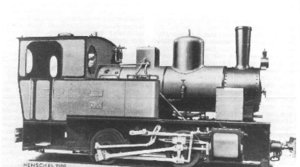Henschel type Helfmann
| Henschel type Helfmann | |
|---|---|
|
Factory photo Henschel
|
|
| Number: | 525 |
| Manufacturer: | Henschel , Kassel |
| Year of construction (s): | 1919-1941 |
| Type : | B n2t |
| Gauge : | 900 mm |
| Length over coupling: | 5,900 mm |
| Height: | 3,300 mm |
| Width: | 2,200 mm |
| Total wheelbase: | 1,800 mm |
| Smallest bef. Radius: | 25 m |
| Empty mass: | 14.6 t |
| Service mass: | 19 t |
| Friction mass: | 19 t |
| Wheel set mass : | 9.5 t |
| Top speed: | 30 km / h |
| Indexed performance : | 118 kW (160 PS) |
| Starting tractive effort: | 46.5 kN |
| Driving wheel diameter: | 800 mm |
| Control type : | Heusinger |
| Number of cylinders: | 2 |
| Cylinder diameter: | 310 mm |
| Piston stroke: | 430 mm |
| Boiler overpressure: | 12 bar |
| Grate area: | 0.8 m² |
| Evaporation heating surface: | 44 m² |
| Water supply: | 2 m³ |
| Fuel supply: | 0.64 t |
| Brake: | Handbrake |
The two-axle narrow - gauge tank locomotives of the Henschel type Helfmann were industrial railway locomotives produced in large numbers by Henschel with a gauge of 900 mm. They were preferred on large construction sites and in larger mines . Some machines are still present today (2020) as memorials or on museum railways.
history
The locomotives were primarily used on construction tracks; as a rule, such systems were built with a gauge of 600 mm, but also in 900 mm. The tracks were mostly simple and not very carefully laid. The freight wagons used were mostly simple tipping trucks .
One of the widespread vehicle series for these areas of activity is the Henschel type Helfmann , of which 525 known examples were built between 1919 and 1941 and were sold all over the world. They were simple in construction, cheap to procure, safe and insensitive to operate, and easy to maintain. They could be heavily overloaded and could be adapted to the respective area of application.
Only with the disappearance of the works trams due to road traffic did the stock decline from the mid-1960s, with only a few locomotives remaining. Five existing locomotives of the Henschel type Helfmann are known.
technology
A simple box frame carries the two-axle engine, the cylinder block and the superstructures. The frame has wide, low-mounted bow buffers at the front and rear, as were common in mining operations. The water supplies are partly in the container between the frame cheeks and partly in the storage containers on the side. The coal was bunkered in the storage container on the left and could be removed from the driver's cab. The conical chimneys were designed with or without a rim, depending on the customer's requirements. Often the locomotive only had a simple headlight with a lantern.
The simple steam boiler carried a steam dome, a rectangular sandpit from which two downpipes on each side of the engine led in front of the wheels in the direction of travel, and a simple safety valve . With the Helfmann design, the steam inlet and outlet pipes were already in the boiler, and the controller drive shaft was also guided in the boiler. The control was implemented with a piston valve. The locomotives had Heusinger controls .
The locomotives only had a simple handbrake that worked from the front on both axles.
literature
- Author collective: Special catalog Henschel construction, light rail, small railroad and industrial locomotives . Henschel and Son AG, Kassel 1936.
- Klaus-Joachim Schrader: Steam locomotives on works railways . Verlag Wolfgang Zeunert, Gifhorn 1977, p. 8-9 .
